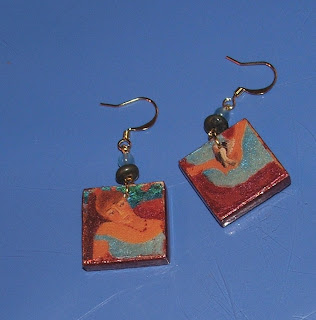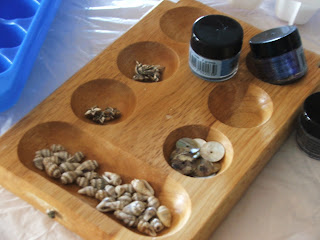Monday Madness: Weekly Earring Project 2
8:56 AM Posted In bead making , earrings , embossing powder , flowers , glossy accents , Pearl Ex Pigments , stamps , tutorial Edit This 1 Comment »Jewelry and Bead Artists are constantly looking for new and unique ways to make their jewelry and beads. I, for one, find myself pacing the aisles or my local craft store, meditating over all kinds of plans of making wondrous creations with the strangest of supplies.
Recently, I strayed upon the idea of Chipboard Jewelry. Scrapbooking enthusiasts know chipboard is a dense cardboard, often printed with nifty designs. Coated with a sealant, chipboard provides a fantastic and lightweight canvas for any kind of bead, pendant or charm you can imagine.
What's The Plan, Stan?
As with domino pendants, there are literally limitless options with Chipboard Jewelry. For this tutorial, I'm going to keep things simple. However, stay tuned for many more creative, fun projects, expanding upon this same idea.
Ingredients
- Chipboard Circles (I purchased some very inexpensive -$0.70- ones at Michaels)
- Silver Metallic Ink
- Clear Embossing powder
- Silver Pearl Ex Pigments
- Small mixing tray (I used the top of a clean baby food container)
- Acrylic paint/gesso
- Floating medium OR water and glue mixture
- Glossy Accents
- Two silver plated jumprings
- Two earwires
- Two beads OR Modified Clasps
- OPTIONAL: Pressed Flower , Fine Black Sharpie
- Drill with extra fine bit
- Scrap piece of wood
- Heat gun
- Floral Stamp (I got a fantastic one at Michaels in their Dollar Bin! Woot!)
- Paint Brush
- Drill each chipboard circle - you'll want to have the hole as close to the edge as possible without weakening the piece - using a scrap piece of wood underneath to protect your work surface.
- Prep the surface: coat both sides of chipboard with acrylic or gesso (or a mix of the two) If you get paint in the whole, that's fine, just poke a pushpin or unfolded paperclip through it and you're golden.
- Mix clear embossing powder with a pinch of silver Pearl Ex Pigment in your mixing tray (or baby food container top :)
- Stamp one side of the chipboard with silver metallic ink. Sprinkle with embossing powder/Pearl Ex Pigment on top of the stamped image and heat with your handy dandy heatgun.
- Once the chipboard has cooled entirely, you can either play around with the colors, using Pearl Ex Pigments or you can leave it as is.
- These earrings were left at this step
- To make these earrings: Gently go over the entire surface with Blue Russet Pearl Ex Pigment (it's actually an antique-like rusty red), which has been mixed with floating medium or water and glue. (Use a soft paintbrush for this, like a watercolor brush) Then, add a wee bit more pigment to your mixture and go over some of the details on the earrings - I covered the flowers and a few of the loopy lines - with a fine paint brush.
- Back side option: You could leave the back blank. OR you could get creative and personalize your earrings.
- To get this effect: Coat the backs with a layer of glue. Apply Misty Lavender, True Blue and Blue Russet. Allow to dry. Coat the back of your flower with glue, set and coat top with glue. Allow to dry. Add your own phrase to the edge of the chipboard. I wrote 'Made With Love'.
- Once everything is dry (and it's really important that it is before you move on!) Begin the Glossing! Apply Glossy Accents to both sides. MAKE SURE THE GLOSSY ACCENTS HAS DRIED COMPLETELY BEFORE TOUCHING IT! Ahem... otherwise you will royally screw it up. Trust Me.
- Once the glossy accents has dried, you have a few more options. You can attach a small jumpring and be done, or you can add an accent bead. Here are two examples of the latter design:
- For one pair of earrings I used one half of two silver plated clasps - I think they make sweet metal findings! For the other pair, I used an undyed howlite round (around 6mm I think), and a silver plated bead cap. Experiment with complimenting and contrasting accent beads and metal findings.
Bead Artist Showcase
- Your work could be pictured right here! Submit your own completed Victorian Inspired Earrings to Creativity In A Nutshell via email at cagarp@plymouth.edu. Feel free to include plenty of pictures, new stuff you tried and any sweet new ideas or suggestions you may have :)
More Stuff on the Information Highway
http://artrix-playtime.blogspot.com/2008/04/chipboard-jewelry.html






















































